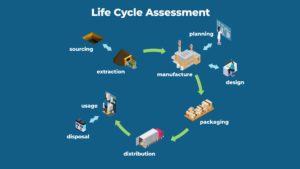Over the course of 2020, the world, and the way we live in it, has changed. We’ve seen proof that when we act collectively, our actions have the ability to conserve, protect and even help recover our natural environment. Now more than ever, the world is depending on companies to make smart, sustainable choices and show the way to a lower carbon economy and sustainable lifestyle. As one of the largest consumer goods companies in the world, we embrace an environmental responsibility to lead with innovation in the area of sustainability, and we’re committed to making a difference.
P&G harnesses the scientific Lifecycle Analysis tool (LCA) as a positive force for achieving Ambition 2030
But in a threatened world where science has become our guiding light, where we have been bombarded with data and numbers, there is an increasing demand from all stakeholders, retailers and consumers to understand the scientific substantiation behind the headline, announcement or social broadcast. In the new normal, facts and science are set to be the key pillars of trust and reputation and the challenge is to progress in a credible, scientifically sound yet simple and understandable way.
Similar to our lifestyle and how we all use products in our daily lives, all consumer products have an impact on the environment at each stage of their life. Beginning at the sourcing of raw materials, to the product’s journey from manufacture, distribution, consumer use and disposal – every step is multifaceted and will leave a mark on the world.
At P&G, we have a history of harnessing science as a positive force for good and for decades have embedded the Life Cycle Assessment into our business choices and strategies to better understand and document our impact of our business and brands. We have used the scientific findings to make informed decisions and drive progress on the road to sustainable innovation, making tools like LCA critical to deliver meaningful reductions in our environmental footprint and achieve our Ambition 2030 goals. The data and technology available today, paired with internal and external expert thinking, makes the LCA more accurate and actionable than ever before. Approved by credible and independent third parties, a Life Cycle Assessment study uncovers the science behind every product story.
With scientific driven knowledge comes the responsibility and opportunity to drive positive change on the environment. LCA studies shows us which hotspots and processes in the full life cycle are causing the highest impacts – such as within manufacturing or packaging – and we then innovate sustainable solutions to reduce the carbon footprint and the other impacts of that phase– such as designing concentrated and compacted formats and formulas to help reduce waste, energy consumption, water use and GHG emissions across the full life cycle. We have the mandate to explain to consumers, our stakeholders and partners, our retailers, now more than ever.
Reducing the impact we have in scope 1&2 is a major effort to which we are committed, but it is also just one piece of the puzzle. Our scientific analysis shows that the largest footprint of our company across all activities, categories and brands is in the ‘in-use’ phase (so called Scope 3), when products are used at home by consumers, specifically when the use involves electricity or heating of water. To alleviate the environmental impacts at this ‘in-use’ stage of the product lifecycle, P&G is committed to educating and influencing responsible consumer behaviour through behaviour change programs such as ‘Turn to 30’, promoting sustainable washing at 30 degrees. But it goes beyond educating consumers. It is equally important that we innovate to produce products that deliver a reduced scope in-use. For example, our detergents have been designed to give brilliant cleaning results in these low energy conditions.
For our dish Care brands like Fairy, more than 90% of the LCA footprint comes from the use phase, again related to the use of warm water during dishwashing, so we invented a highly concentrated product that uses less water (which is cold water). Now, the brand is informing consumers that a highly efficient, concentrated dishwashing product is the right choice to reduce water and energy use. This can save up to 13L water per wash and 50% CO2.
In Fabric Care, brands like Ariel have leveraged findings to help innovate smart sustainable solutions where it matters. This has seen the ongoing reformulation of our liquid and powder laundry detergents into more concentrated and compacted forms that continue to be effective when they are dosed in low quantities. This helps to reduce waste and emissions resulting in our European operations using 28% less energy and 22% less water to make the same amount of products vs. 2010.
It is the role of big brands and Companies to elevate the importance of science and make it accessible to consumers. Now more than ever, P&G and others are acting as a force for good, embracing advancements in data and technology to achieve the scale and speed needed to accelerate big change, specifically in the areas of climate neutrality & responsible consumption. In this defining decade for our planet, we know it has never been more important to embed the scientific insights from Lifecycle analysis into our sustainability strategy and harness the LCA science to help strengthen our ability to conserve, protect and even renew our natural environment.
This blog was written and contributed by:
P&G Director Global Product Stewardship and Sustainability, Scientific External Relations



